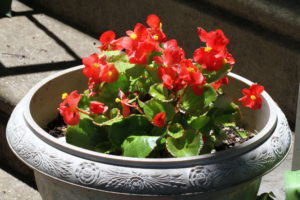Begonias are a favorite amongst homeowners because of their size, versatility, and beautiful colors. Begonias can be grown in the ground, containers, hanging planters, and more! Containers are popular with begonia owners because it gives you the freedom to decorate a porch, a front door, a deck, or any outdoor space. In warmer climates, begonias are hardier, while in cooler climates they are grown as annuals.
Planting Begonias

Unless you live in growing zones 9+, begonias should be started indoors. This will give the bulbs time to warm up during their Winter dormancy. Begonias only require partial sun, so they should be planted on the East or West sides of your home. Start your begonias indoors 10 weeks before the last frost in your growing zone. Fill your containers or trays with enough nutrient rich soil to cover the bulb. Water occasionally every few days to avoid rot. Begonia bulbs are very prone to rotting due to overwatering. If you started indoors, expect to see growth in about 4 weeks. Containers should be at a minimum 6 inches in diameter, but may grow better in 8+ inch containers.
If planting outside, space the tubers about 1 foot apart. The soil should be loamy, nutritious, and well drained. When planting outside be aware of your frost dates as begonias cannot survive frost and temperatures below 45 degrees.
Begonia Management
Some begonias are trailing while others grow upright, this depends on variety. Consult the company you purchased the bulbs from to know ahead of time because some varieties of begonias grow better when staked.
Begonias are heavy feeders and grow best when well fertilized. We recommend a 15-15-15 or 20-20-20 npk fertilizer. If you’re growing in containers, liquid fertilizers are easier to apply.
Begonias will require pruning to produce the desired look of round uniformity. If a branch grows larger than others, pinch or cut them back to maintain uniformity. Sometimes flowers will appear dead, remove any flowers or heads that look discolored.
When your begonias die off, you can dig up the tuber after the first frost and replant it next year! To store the removed tuber, lay it between several layers of paper or dry sand and keep in a dry cool area.

Begonias Pests and Diseases
Aphids, mealy bugs, and scales are common sap sucking insects that will cluster under the leaves of your begonias. A few will not harm the begonias, but an infestation will begin to cause the leaves to yellow and curl. A light spraying of insecticidal soap, neem oil, and inviting beneficial insects like ladybugs to eat them should help.

Spider mites are so tiny they may not even be noticed unless there is a large infestation. They suck on the sap from the begonias, and in large groups can form tiny web like structures between flowers. Applying insecticidal soaps, neem oil, and inviting beneficial insects should get spider mites under control.
Thrips will leave the flower leaves looking damaged with silvery speckles and lines throughout. Gently dust your begonias with diatomaceous earth to control thrips. Thrips can also cause impatiens necrotic spot virus and tomato spotted wilt virus which will cause black spots and wavy rings to form. If either of these viruses set in, you will need to discard of the begonia plant.
Botrytis blight is a fungus that will cause rot and irregular spots of brown. If caught early, a copper-based fungicide or neem oil can be applied. If most of the plant is covered in botrytis you will need to throw it out.
Powdery mildew will leave white fluffy mold on the begonia leaves. Powdery mildew is easy to manage with neem oil or copper-based fungicides.
Pythium root and stem rot are a bit harder to detect as they occur below the soil level. Typically, your plant will look wilted and die after some time has passed. To prevent rotting, make sure your soil is well drained.

Contact Author
 info@gardensavvy.com
info@gardensavvy.com Recent Posts
- Smart Gardening: How Technology Is Revolutionizing Horticulture
- Understanding Gardening Zones: What You Need to Know
- The Right Tools For Your Gardening And Landscaping Needs
- Maximizing Your Harvest: Square Foot Gardening Chart for Beginners
- Holiday Garden Scents: Plants for Natural Aromatherapy in Your Home









